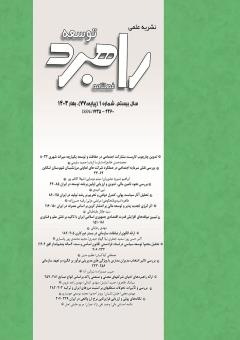تحلیل محتوا توسعه سیاسی دراسناد فرادستی (قانون اساسی و سند20ساله چشمانداز افق 1404)
محورهای موضوعی :
مصطفی کواکبیان
1
![]() ,
عظیم متین
2
,
عظیم متین
2
![]()
1 - عضو هیئت علمی گروه علوم سیاسی ، دانشگاه علامه طباطبایی- تهران
2 - دانشگاه علامه طباطبایی - تهران
کلید واژه: کلمات کلیدی: قانون اساسی, سند چشمانداز, توسعه سیاسی, مشارکت شهروندان, ثبات سیاسی.,
چکیده مقاله :
چكيده این پژوهش به بررسی پیچیدگیهای توسعه سیاسی در جمهوری اسلامی ایران با تمرکز ویژه بر تلاقی حاکمیت قانون اساسی و برنامهریزی استراتژیک میپردازد. این پژوهش با تأکید بر لزوم بررسی عمیق قانون اساسی و سند چشمانداز ۲۰ساله 1404، به بررسی تأثیر متقابل بین اصول قانون اساسی ریشه در فقه اسلامی و اهداف تحولآفرین ترسیمشده در چشمانداز بلندمدت میپردازد. این مطالعه با استفاده از روش تحلیل محتوای تلخیصی، جایگاه توسعه سیاسی را هم در قانون اساسی و هم در سند افق ۲۰ساله بررسی کرده و پویایی پیچیده شکلدهنده مسیر سیاسی ایران را آشکار میکند. این یافتهها ماهیت دولتمحور و از بالا به پایین توسعه سیاسی را روشن میسازد و چالش همسویی برنامههای توسعه با آرمانهای دموکراتیک و مشارکت شهروندان را برجسته میکند. این تحلیل نهتنها مباحث آکادمیک در مورد توسعه سیاسی را غنی میکند، بلکه بینشهای ارزشمندی را در اختیار سیاستگذاران قرار میدهد تا در چشمانداز متمایز اجتماعی - سیاسی جمهوری اسلامی ایران حرکت کنند. درنهایت، این مطالعه بر تأکید قانون اساسی بر مشارکت شهروندان و اصول دموکراتیک بهعنوان عناصر اساسی برای تقویت ثبات سیاسی و اجتماعی تأکید دارد.
This research delves into the intricate facets of political evolution within the framework of the Islamic Republic of Iran, particularly focusing on the confluence of constitutional governance and strategic foresight. Underlining the imperative of a meticulous scrutiny of both the constitutional framework and the 20-year vision document of 1404, this inquiry probes into the reciprocal influence between the foundational precepts of the constitution, steeped in Islamic jurisprudence, and the transformative objectives delineated in the long-term perspective. Employing a methodical content analysis, the study scrutinizes the stance on political evolution as articulated in both the constitutional provisions and the 20-year horizon document, elucidating the nuanced dynamics that mold Iran's political trajectory. These revelations illuminate the state-driven, hierarchically structured nature of political advancement, underscoring the formidable task of harmonizing developmental initiatives with democratic principles and citizen engagement. This examination not only enriches scholarly discourse surrounding political progression but also furnishes policymakers with invaluable insights to navigate the distinctive socio-political terrain of the Islamic Republic of Iran. Lastly, this study underscores the constitutional emphasis on citizen participation and democratic values as pivotal components for fortifying political and social equilibrium.


